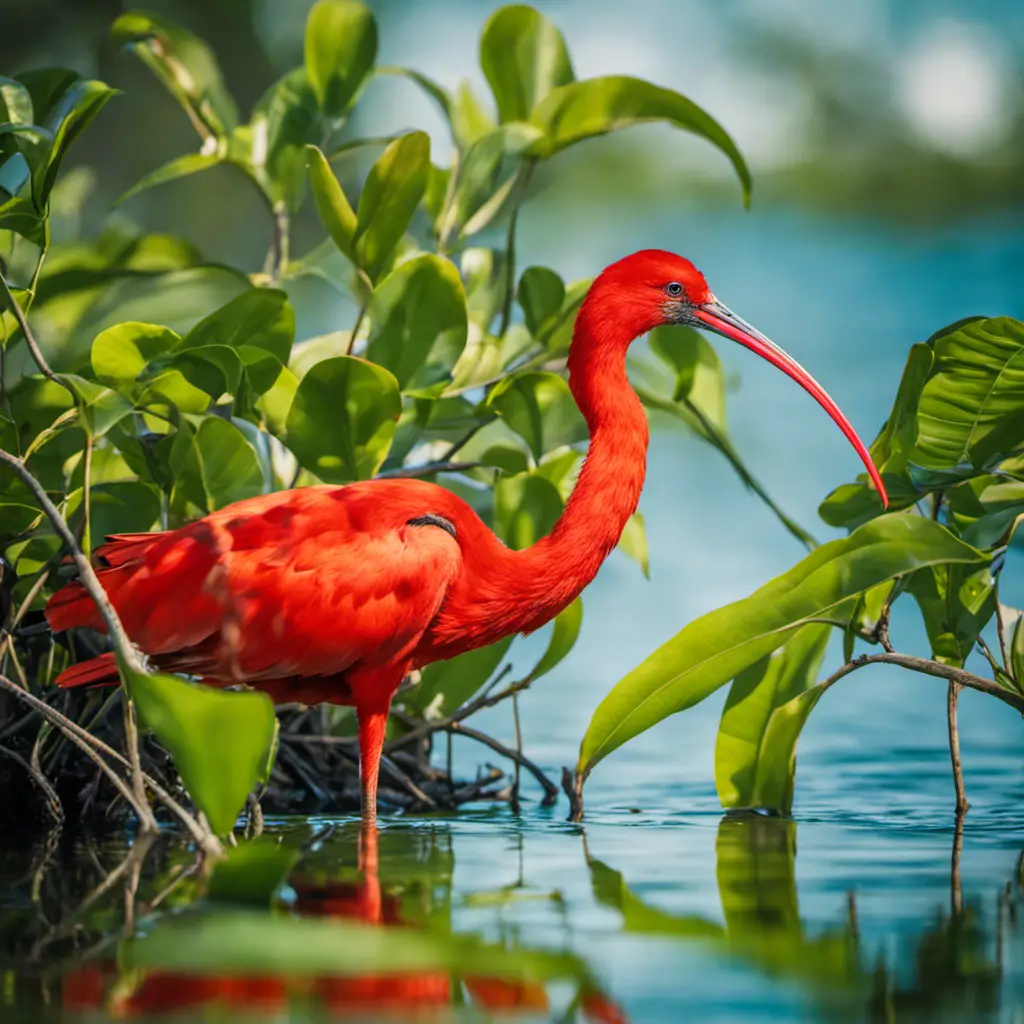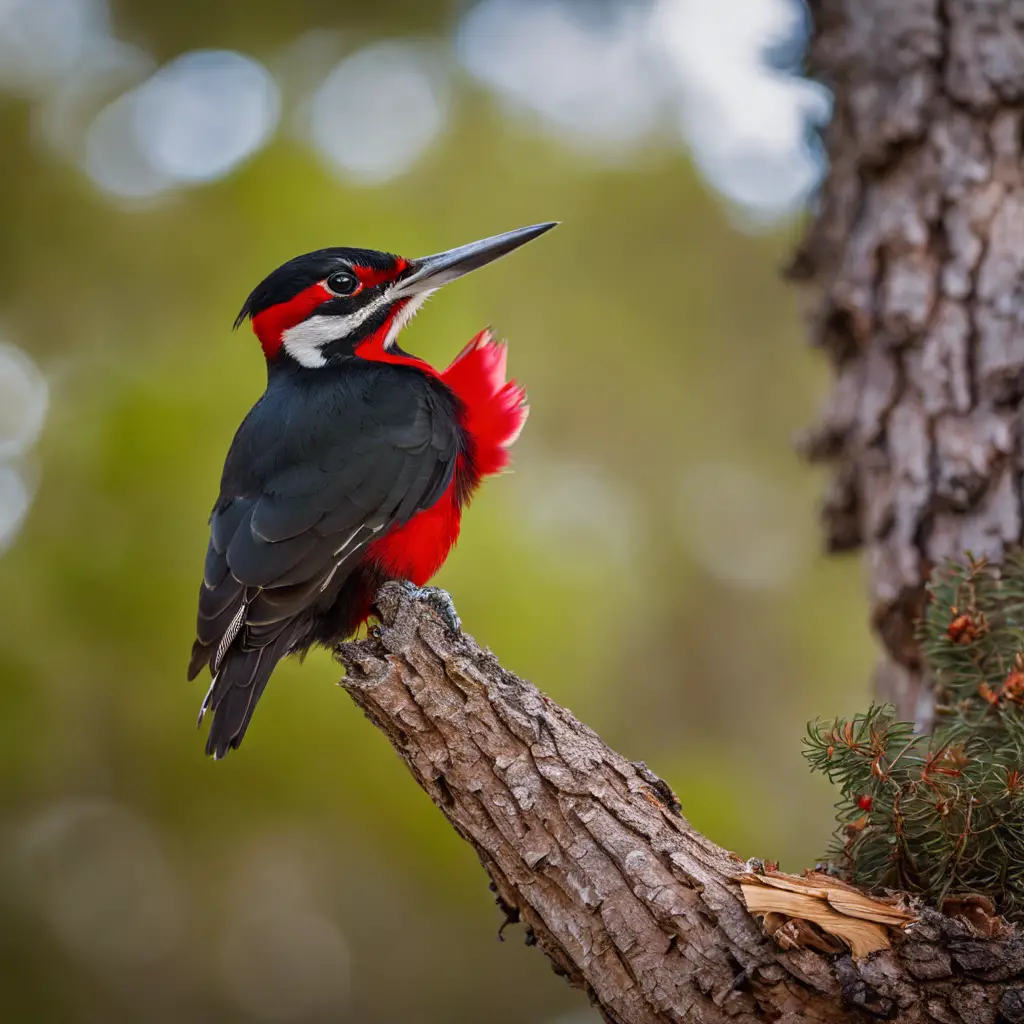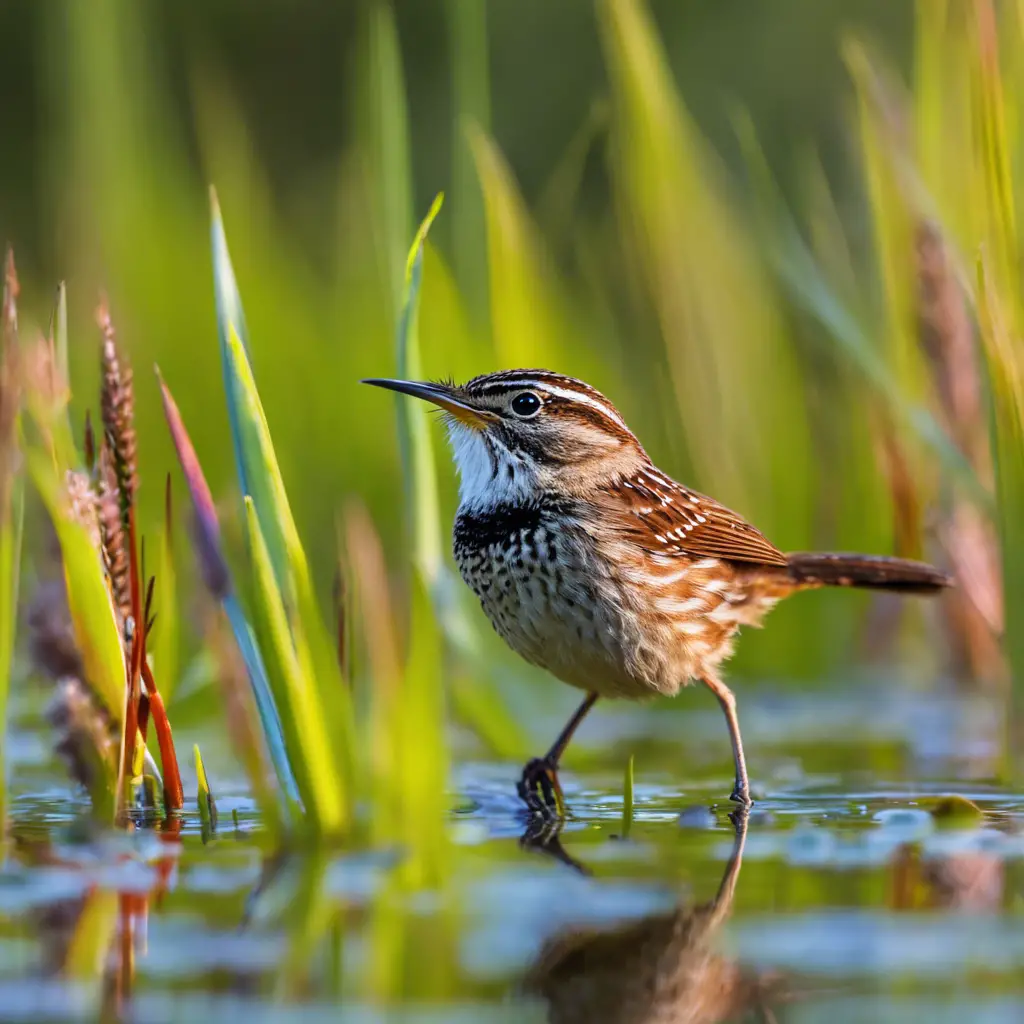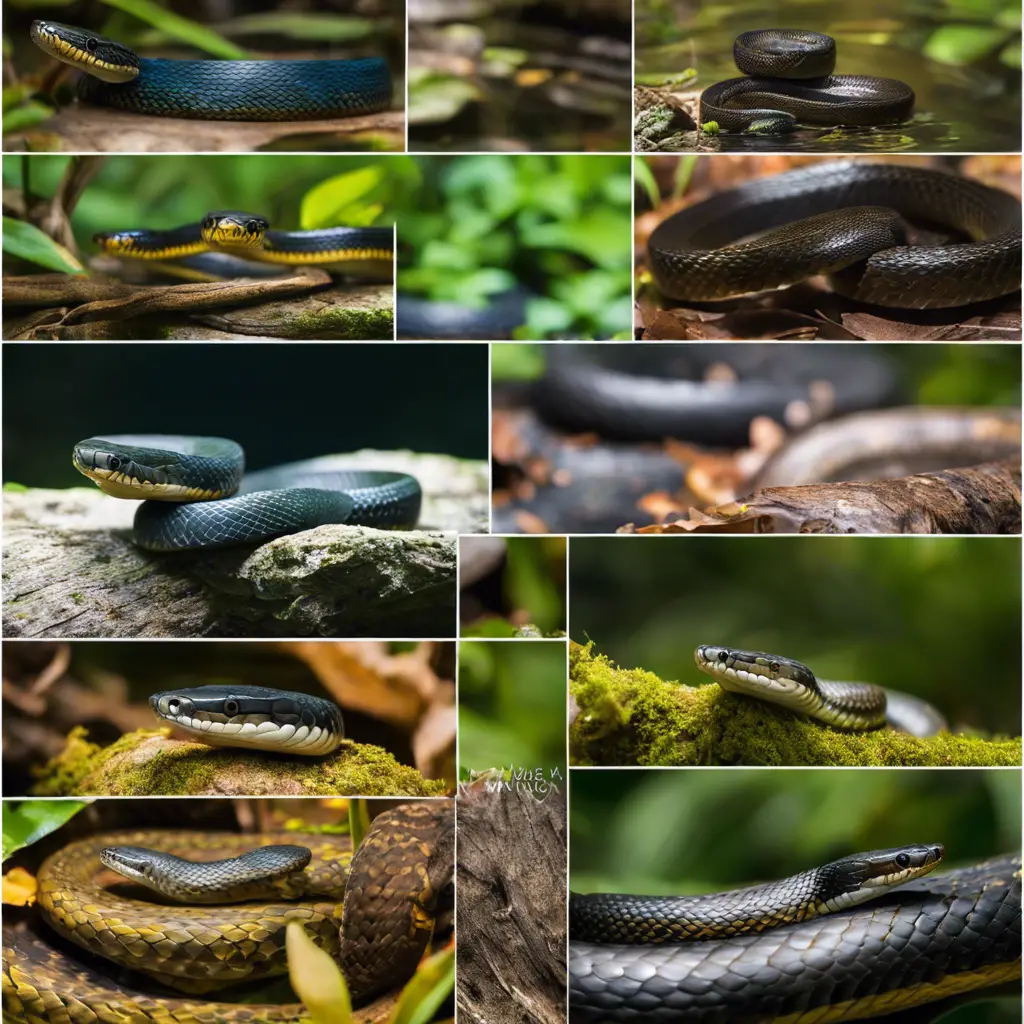Welcome to an insightful article on the vibrant red birds found in the diverse ecosystem of Florida. This piece will explore the Northern Cardinal, Summer Tanager, Scarlet Tanager, Vermilion Flycatcher, Painted Bunting, American Redstart, Red-breasted Merganser, Red-eyed Vireo, and Red-throated Loon.
Delving into their distinct characteristics and habitats, this objective and scientifically grounded analysis aims to provide a comprehensive understanding of these avian species.
Prepare to immerse yourself in the captivating world of red birds in Florida.
Key Takeaways
- The Northern Cardinal, Summer Tanager, Scarlet Tanager, Vermilion Flycatcher, and Painted Bunting are some of the red bird species found in Florida.
- Red birds in Florida have diverse diets, including seeds, insects, berries, fruits, and nuts.
- Conservation efforts for red birds in Florida focus on habitat preservation, suitable nesting site availability, sustainable forest management practices, and collaborative partnerships.
- Other red bird species found in Florida include the Red-shouldered Hawk, Red Knot, Reddish Egret, Reddish-brown Crested Caracara, and Red-whiskered Bulbul.
Northern Cardinal

The Northern Cardinal is a common bird species found in North America. It is known for its vibrant red plumage and distinctive crest. These birds inhabit a variety of habitats, including woodlands, gardens, shrublands, and urban areas.
They are primarily found in the eastern and central parts of the United States, but their range extends into parts of Mexico and Canada. Northern Cardinals are territorial birds and can be quite aggressive in defending their territory. They are known to sing throughout the year, with the males often singing to establish their territory and attract mates.
They have a varied diet, feeding on seeds, fruits, insects, and even small vertebrates. Overall, the Northern Cardinal is a fascinating bird species with unique behaviors and adaptability to different habitats.
Summer Tanager

One interesting fact about the Summer Tanager is that it is the only entirely red bird species in North America. This vibrant bird can be found across the continent, from the southeastern United States to Central America.
Here are three key points about the Summer Tanager:
Breeding habits: The Summer Tanager is known for its unique breeding behavior. Unlike many other bird species, the male Summer Tanager takes on different plumage during breeding season. It transitions from a bright red color to a striking yellow, resembling the female. This change in coloration helps the male blend in with the female and protect their nest from potential predators.
Migration patterns: The Summer Tanager is a long-distance migratory bird. During the winter months, it migrates to Mexico, Central America, and South America. It travels thousands of miles to find suitable wintering grounds with abundant food resources.
Habitat preferences: Summer Tanagers are commonly found in open woodlands, forests, and shade-grown coffee plantations. They prefer areas with tall trees, where they can forage for insects and berries. These birds are also known to visit backyard feeders, especially during migration periods.
Understanding the breeding habits and migration patterns of the Summer Tanager is crucial for conservation efforts and ensuring the long-term survival of this beautiful bird species.
Scarlet Tanager
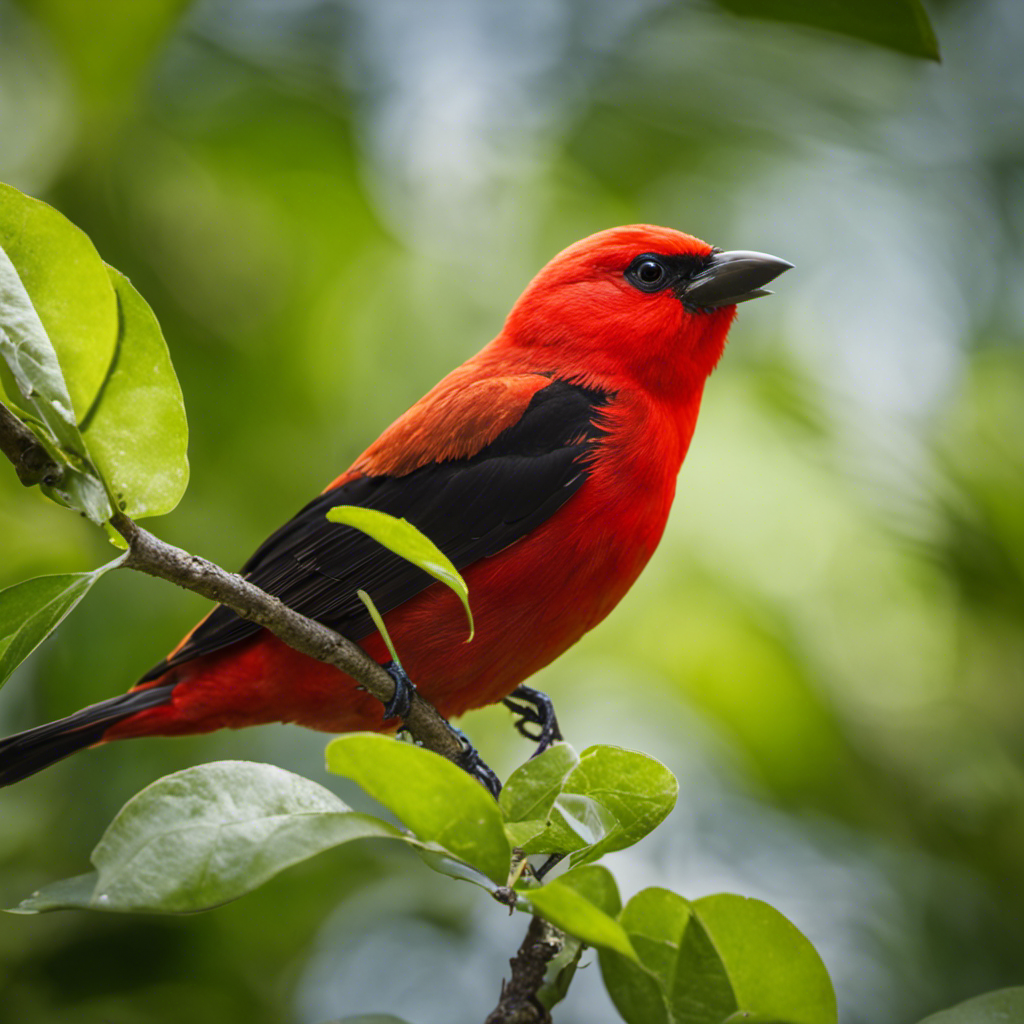
An interesting fact about Scarlet Tanager is that it is known for its striking red plumage and can be found in various habitats across North America.
Scarlet Tanagers are neotropical migrants, meaning they undertake long-distance migrations between their breeding grounds in North America and their wintering grounds in South America.
These birds breed in deciduous and mixed forests, where they build cup-shaped nests and lay 3-5 eggs.
During migration, they navigate using a combination of celestial cues and landmarks, such as rivers and coastlines.
Scarlet Tanagers primarily feed on insects, but they also consume fruits and berries.
In order to prepare for their long migrations, these birds undergo a process called hyperphagia, where they consume large amounts of food to store energy as fat.
Understanding the migration patterns and habitat requirements of Scarlet Tanagers is crucial for their conservation and management.
Vermilion Flycatcher
Although smaller in size, the Vermilion Flycatcher possesses a similar vibrant red plumage as the Scarlet Tanager, making it a visually striking bird found in the southern regions of North and South America.
This bird species is known for its fascinating mating habits and migration patterns. Here are three interesting facts about the Vermilion Flycatcher:
Mating Habits: During the breeding season, male Vermilion Flycatchers perform elaborate courtship displays to attract females. They perch on exposed branches, flick their wings, and sing melodious songs to showcase their fitness and attractiveness. The female then chooses a mate based on these displays.
Migration Patterns: The Vermilion Flycatcher is a partially migratory bird, with some populations migrating long distances, while others are resident. The migratory individuals undertake extensive journeys, flying from their breeding grounds in the southern United States and Mexico to their wintering grounds in Central and South America.
Nesting Behavior: Vermilion Flycatchers build their nests in open areas such as shrubs and trees. The female constructs a cup-shaped nest using grass, plant fibers, and spider silk, which she lines with softer materials like feathers. Once the nest is complete, the female lays a clutch of eggs and incubates them until they hatch.
Understanding the Vermilion Flycatcher’s mating habits and migration patterns provides valuable insights into the ecology and behavior of this stunning bird species.
Painted Bunting
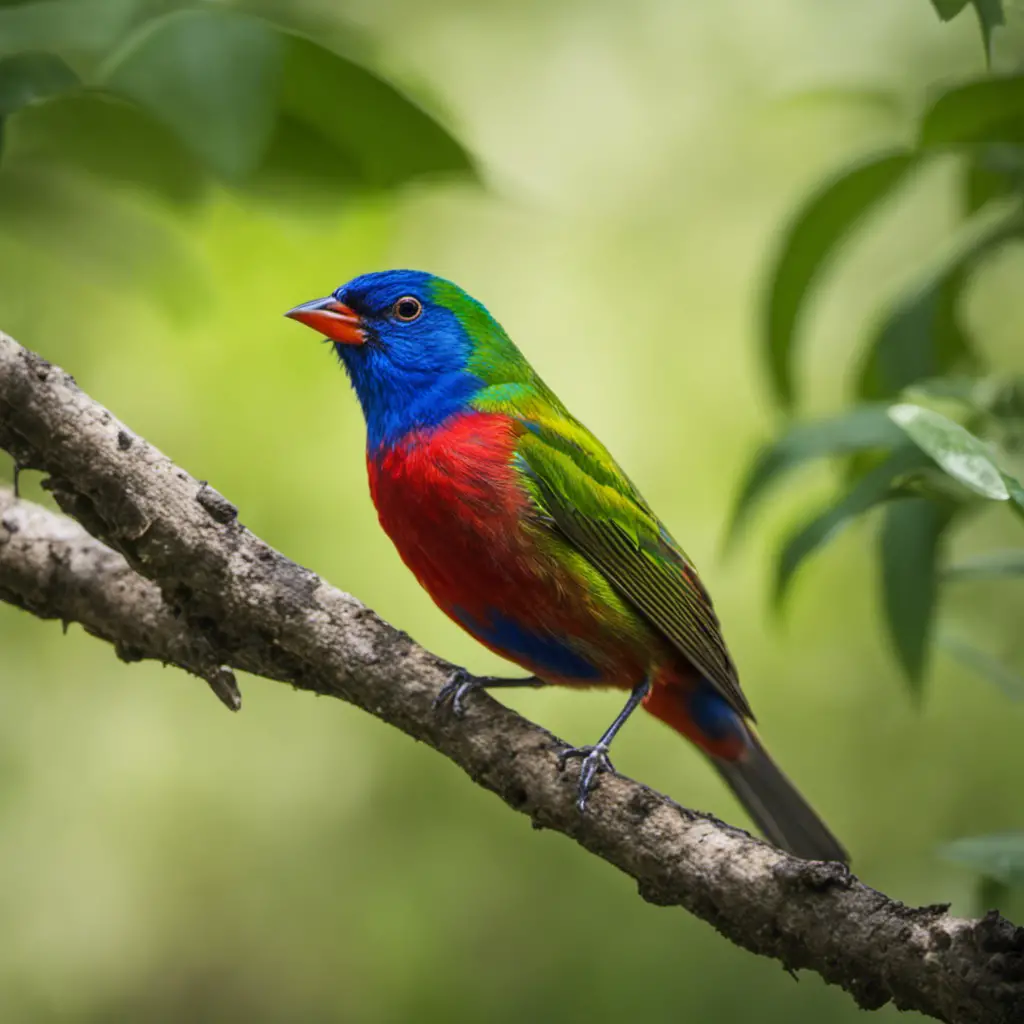
The vibrant plumage of the Painted Bunting, a small songbird native to North America, makes it a highly sought-after species among birdwatchers and nature enthusiasts. This colorful bird is known for its striking combination of red, blue, and green feathers. The male Painted Bunting is particularly eye-catching, with its bright blue head, green back, and red underparts. The female, while more subtly colored, still displays shades of green and yellow.
One of the unique features of Painted Buntings is their migration patterns. These birds breed in the southeastern United States and spend their winters in Mexico, Central America, and the Caribbean. During migration, they can cover hundreds of miles, making stops along the way to rest and refuel.
To better understand the characteristics of the Painted Bunting, refer to the table below:
| Feature | Description |
|---|---|
| Plumage | Vibrant combination of red, blue, and green |
| Size | Small songbird |
| Habitat | Woodlands, brushy areas, and thickets |
| Diet | Seeds, insects, and berries |
| Conservation status | Species of concern due to habitat loss and capture for the pet trade |
Rose-breasted Grosbeak

One notable characteristic of the Rose-breasted Grosbeak is its distinctive black and white plumage, with a vibrant splash of red on its breast. This medium-sized songbird is known for its striking appearance and melodious song.
The Rose-breasted Grosbeak is a migratory bird, with a range that spans across North America. As it embarks on its annual journey, here are three fascinating aspects of its migration:
Timing: The Rose-breasted Grosbeak typically begins its migration in early May, traveling from its wintering grounds in Central and South America to its breeding grounds in North America. Its arrival coincides with the blooming of trees and the abundance of insects, ensuring a steady food supply.
Routes: These birds navigate through various routes during their migration, with some individuals traveling along the eastern coast of North America, while others opt for a more inland route. They face numerous challenges, such as weather conditions and potential predators, as they make their way to their destination.
Wintering grounds: During the winter months, the Rose-breasted Grosbeak can be found in the lush tropical forests of Central and South America. These areas provide a suitable habitat with ample food resources, allowing the birds to survive until they embark on their migration once again.
Understanding the intricacies of the Rose-breasted Grosbeak’s migration is crucial for conservation efforts and ensuring their continued presence in our ecosystems. By studying their patterns and behavior, scientists can gain valuable insights into the challenges faced by migratory birds and develop strategies to protect their habitats along their migratory routes.
Red-headed Woodpecker

The conservation efforts aimed at preserving the habitat of the Red-headed Woodpecker are paramount in ensuring the long-term survival of this distinctive bird species.
The Red-headed Woodpecker (Melanerpes erythrocephalus) is a medium-sized woodpecker found in North America. Its habitat consists of mature deciduous forests, open woodlands, and wooded swamps.
These birds are known for their striking red head, black wings, and white underparts. Red-headed Woodpeckers are primarily insectivorous, feeding on a variety of insects, including beetles, ants, and grasshoppers. They also consume fruits, nuts, and seeds, especially during the winter months when insects are scarce. This species is known for its unique behavior of storing food for later consumption by wedging it into crevices or bark.
However, the Red-headed Woodpecker population has been declining due to habitat loss and degradation. Conservation efforts focus on preserving and restoring their habitat, ensuring the availability of suitable nesting sites, and promoting sustainable forest management practices.
These efforts are crucial to the conservation of this species and its long-term survival.
Red-bellied Woodpecker

During the breeding season, the Red-bellied Woodpecker can be observed excavating nest cavities in dead or dying trees, providing vital shelter for their offspring. This medium-sized woodpecker is known for its vibrant red head and nape, contrasting with its pale belly.
Here are three birdwatching tips to help you spot and identify the Red-bellied Woodpecker:
Listen for its distinctive call: The Red-bellied Woodpecker’s call is a loud, rolling ‘kwirr’ or ‘churr’ sound that can be heard from a distance. Listen for this unique vocalization to locate the bird.
Look for its habitat: Red-bellied Woodpeckers can be found in a variety of habitats, including woodlands, forests, and suburban areas with trees. They prefer dead or dying trees for nesting, so keep an eye out for these potential nesting sites.
Observe its behavior: Red-bellied Woodpeckers are active foragers, often seen hopping up and down tree trunks in search of insects or drumming on trees to communicate. Watch for these behaviors to confirm the presence of a Red-bellied Woodpecker.
Red-cockaded Woodpecker

An endangered species, the Red-cockaded Woodpecker (Picoides borealis) is known for its distinctive black and white plumage and its preference for living in mature pine forests. This small woodpecker is found primarily in the southeastern United States, including Florida, where it faces significant conservation challenges.
Red-cockaded Woodpecker populations have declined due to habitat loss and degradation, primarily resulting from logging and urban development. These birds require large, contiguous tracts of mature pine forests with open understory for foraging and nesting.
Efforts to conserve the Red-cockaded Woodpecker have focused on habitat restoration and protection, including the creation of artificial cavities and the implementation of prescribed burning to maintain suitable habitat conditions. Collaborative partnerships between landowners, government agencies, and conservation organizations play a crucial role in the recovery of this species.
Continued efforts are necessary to ensure the long-term survival of the Red-cockaded Woodpecker and its vital role in maintaining the health of mature pine ecosystems.
Red-tailed Hawk

Amidst the ongoing discussion about the Red-tailed Hawk, it is crucial to evaluate its impact on local ecosystems and the measures needed to ensure its conservation. The Red-tailed Hawk (Buteo jamaicensis) is a large bird of prey known for its distinctive red tail feathers. Here are three key points to consider when discussing the Red-tailed Hawk:
Bird Migration Patterns: The Red-tailed Hawk is a highly migratory species, with populations that breed in North America and winter in Central and South America. Understanding their migration patterns is essential for effective conservation efforts, as it helps identify critical stopover sites and potential threats along their migratory routes.
Ecological Role: Red-tailed Hawks play a vital role in local ecosystems as top predators. They help control populations of small mammals, such as rodents, which can have significant impacts on agricultural lands and human health.
Conservation Efforts: To ensure the conservation of Red-tailed Hawk populations, it is important to focus on habitat protection, mitigating threats such as habitat loss, pesticide use, and collision with structures like wind turbines. Additionally, monitoring and research are essential to track population trends and understand the species’ response to changing environmental conditions.
Red-shouldered Hawk

Given the information previously discussed about the Red-tailed Hawk, it is important to now shift our attention to the ecological significance of the Red-shouldered Hawk and how its presence impacts local ecosystems.
The Red-shouldered Hawk (Buteo lineatus) is a medium-sized bird of prey that is native to North America. It is known for its distinctive red shoulders and barred underparts.
This species plays a crucial role in maintaining the balance of ecosystems by controlling populations of small mammals, reptiles, and amphibians.
The Red-shouldered Hawk is also known for its unique migration patterns, with some individuals traveling long distances during the winter months.
However, habitat loss and human activities have posed significant threats to this species.
Conservation efforts, such as protecting nesting sites and preserving suitable habitats, are essential for the survival of the Red-shouldered Hawk and maintaining healthy ecosystems.
Red Knot

The decline in the population of the Red Knot is a matter of concern among conservationists, who are working tirelessly to preserve the bird’s coastal habitats and mitigate the impact of climate change on its migratory patterns.
Red Knots are fascinating creatures known for their long-distance migrations, which span thousands of miles. Here are three key aspects of their migration patterns:
Impressive distances: Red Knots undertake one of the longest migrations of any bird species, traveling from their breeding grounds in the Arctic tundra to their wintering grounds in the southern hemisphere. They cover distances of up to 9,000 miles, making stops along the way to rest and refuel.
Critical stopover sites: During their migration, Red Knots rely on specific coastal habitats as crucial stopover sites. These areas provide essential food resources, such as horseshoe crab eggs, which fuel their journey. Conservation efforts aim to protect and restore these vital stopover sites to ensure the survival of the species.
Global collaboration: Red Knots have a vast distribution range, and their migration routes span across several countries. Conservation efforts require international collaboration, as different regions play a role in the bird’s survival. By working together, conservationists can implement effective measures to safeguard the Red Knot and its fragile migration patterns.
Reddish Egret

During their foraging activities, Reddish Egrets display unique feeding behaviors, such as their distinctive ‘dancing’ display, where they use their wings to create shade and attract prey. This behavior of the Reddish Egret has attracted the attention of researchers and conservationists who are interested in studying and protecting these fascinating birds.
The reddish egret, also known as Egretta rufescens, is a medium-sized heron found along the coasts of the Americas. They have a distinct reddish-brown plumage and a slender body, making them easily recognizable. Reddish egrets are known for their agile hunting techniques, which involve walking or running through shallow water, flapping their wings, and using their long, sharp bills to catch fish and other small prey.
These feeding behaviors are not only fascinating to observe but also play a crucial role in the ecological balance of their habitats. Efforts are being made to conserve the reddish egret populations and protect their habitats to ensure their long-term survival.
Reddish-brown Crested Caracara

Observing the reddish-brown Crested Caracara’s distinctive hunting techniques, such as soaring through the sky and swooping down to catch prey, can provide valuable insights into their foraging strategies. This magnificent bird, found in the diverse habitats of Florida, exhibits fascinating behavior that is worth exploring. Here are three key aspects to consider:
Habitat: The Crested Caracara can be found in a variety of habitats, including grasslands, wetlands, and open woodlands. They prefer areas with scattered trees or cacti, which provide perches for hunting and nesting.
Conservation Status: The conservation status of the Crested Caracara is of concern. It is listed as threatened in Florida due to habitat loss, pesticide use, and collisions with vehicles.
Red Coloration: The red coloration of the Crested Caracara serves important evolutionary adaptations. It allows them to blend in with the surrounding vegetation, making it easier to ambush their prey. Additionally, the red coloration may play a role in sexual selection, attracting mates and signaling reproductive fitness.
Understanding the habitat and behavior of the reddish-brown Crested Caracara, as well as its conservation status and threats, is crucial for effective conservation efforts and the preservation of this remarkable species in the Florida ecosystem.
Red-whiskered Bulbul

Amidst the diverse avian species found in Florida, the captivating red-whiskered bulbul stands out with its vibrant plumage and melodious song. Native to Southeast Asia, this small passerine bird has established feral populations in parts of Florida.
The red-whiskered bulbul is known for its distinct red crest, black tail, and white belly. It is an omnivorous species that feeds on fruits, insects, and nectar. The bird’s behavior is characterized by its active foraging and social interactions, often seen in small groups or pairs.
While the red-whiskered bulbul’s presence in Florida adds to the state’s biodiversity, its introduction has raised concerns about potential impacts on native bird species and ecosystems. As a result, conservation efforts are underway to monitor and manage the population of this non-native species.
Red-winged Blackbird
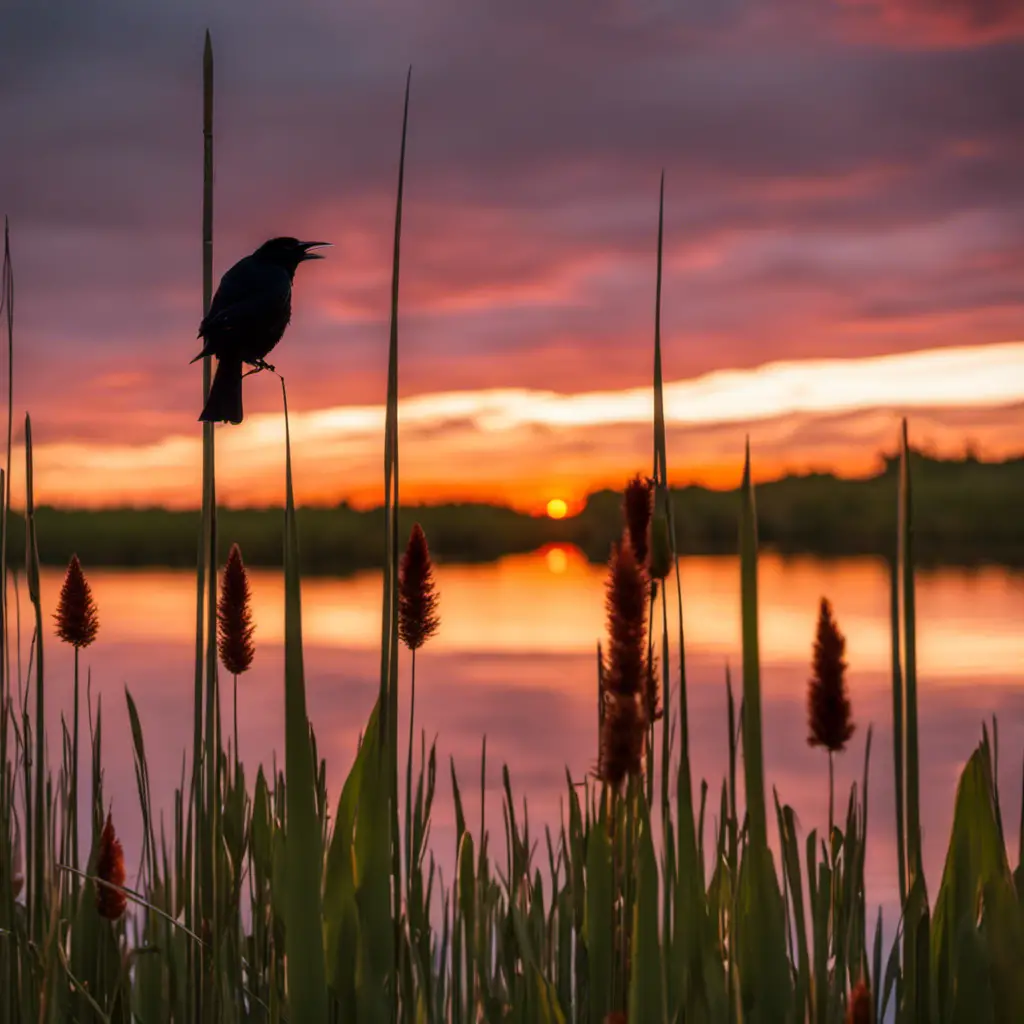
The Red-winged Blackbird, characterized by its distinctive red shoulder patches, is a migratory bird species that exhibits territorial behavior during the breeding season. These birds are known for their striking appearance and unique behaviors.
Here are three aspects of their behavior that contribute to their interesting nature:
Territorial displays: Male Red-winged Blackbirds defend their breeding territories by displaying their vibrant red shoulder patches and singing loudly from prominent perches. This behavior signals to other males that the territory is already occupied.
Aggressive defense: Male Red-winged Blackbirds aggressively defend their territories against intruders, often engaging in aerial chases and physical confrontations. They will also defend their nests and mates from potential threats.
Mating rituals: During courtship, males perform elaborate displays by puffing up their feathers, spreading their wings, and singing complex songs. They use these displays to attract females and establish their dominance among competitors.
Understanding the red-winged blackbird migration patterns and mating behavior provides valuable insight into the biology and ecology of this fascinating bird species.
American Redstart

Interestingly, the American Redstart, known for its striking black and orange plumage, displays similar territorial behavior to the Red-winged Blackbird.
During the breeding season, the American Redstart exhibits highly aggressive behavior towards intruders, defending its territory vigorously. It is known to engage in aerial chases and physical confrontations with rival males.
The American Redstart is a migratory bird, spending its breeding season in North America and then migrating to Central and South America for the winter. Its migration patterns are unique, as it follows a broad front migration strategy, meaning that individuals from a population spread out across a wide geographic range migrate at the same time.
This behavior suggests that the American Redstart relies on environmental cues rather than social interactions to determine the timing of its migration.
Overall, the American Redstart’s behavior during the breeding season and its migratory patterns provide fascinating insights into avian ecology.
Red-breasted Merganser

A significant number of red-breasted mergansers have been observed in coastal areas of Florida, indicating their presence in the region during the winter months. These migratory birds, known for their vibrant red-breasted plumage, are a sight to behold. Here are three fascinating aspects of their migration patterns:
Long-distance travelers: Red-breasted mergansers embark on impressive journeys, flying thousands of miles from their breeding grounds in northern North America to their wintering grounds in Florida. Their ability to navigate such vast distances showcases their remarkable adaptation to migratory life.
Coastal dwellers: These birds prefer coastal habitats, such as estuaries, bays, and inlets. Their presence in Florida’s coastal areas suggests the availability of suitable foraging and roosting sites. Coastal environments provide them with an abundance of fish and crustaceans, which form the majority of their diet.
Winter escape: Red-breasted mergansers migrate south to escape the harsh winter conditions in their breeding grounds. The warmer climate and ample food resources in Florida offer them a favorable environment to survive the winter months until they return to their breeding grounds in the spring.
Understanding the red-breasted merganser’s bird migration patterns provides valuable insights into their ecology and helps in the conservation efforts for these magnificent birds.
Red-eyed Vireo

Although not as brightly colored as the red-breasted merganser, the red-eyed vireo is a small songbird that is known for its distinctive red eyes and melodious songs.
The red-eyed vireo is a migratory bird that breeds in North America and spends its winters in Central and South America. Their migratory patterns are fascinating, as they undertake long-distance journeys twice a year.
During the breeding season, red-eyed vireos prefer deciduous and mixed forests, where they build cup-shaped nests using twigs, grass, and spider silk. The female lays 3-4 eggs and both parents take turns incubating them for about two weeks.
Once the eggs hatch, the parents tirelessly feed the chicks with insects, spiders, and caterpillars. The red-eyed vireo’s nesting behavior showcases their commitment to raising their young and ensuring their survival.
Red-throated Loon
The breeding plumage of the Red-throated Loon is characterized by a stunning double collar of red and white feathers around its neck. This distinctive feature sets it apart from other loon species. To visualize this beautiful bird, imagine a sleek body gliding smoothly on water, with a slender neck adorned by a striking collar of vibrant red and white feathers.
The Red-throated Loon is also known for its graceful dives into the water. As it disappears beneath the surface, there is a flash of its red-throated plumage. This behavior adds to the allure of this magnificent bird.
In addition to its diving skills, the Red-throated Loon showcases its majesty during flights across vast stretches of water. Its red throat is clearly visible against the backdrop of its black and white body. This striking contrast makes it a captivating sight to behold.
In terms of migration patterns, the Red-throated Loon undertakes long-distance migrations. It travels from its breeding grounds in the Arctic to wintering areas along coastlines and large bodies of water. This journey showcases the remarkable endurance and adaptability of this species.
When it comes to nesting habits, the Red-throated Loon prefers to build its nests near water bodies. It often constructs them on islands or along the shores. These nests are often simple depressions lined with vegetation. This nesting behavior highlights the species’ close association with water and its need for a suitable habitat.
Overall, the Red-throated Loon is a fascinating species that captivates with its beauty and intriguing behaviors. Its stunning breeding plumage, graceful dives, majestic flights, and nesting habits make it a truly remarkable bird.
Frequently Asked Questions
What Is the Typical Diet of the Red Birds in Florida?
The typical diet of red birds in Florida includes a variety of foods such as insects, seeds, berries, and fruits. Red birds exhibit specific foraging patterns and feeding habits that are influenced by their natural environment and availability of resources.
Are the Red Birds in Florida Migratory or Year-Round Residents?
Migratory patterns of certain bird species have been a subject of scientific inquiry. Understanding the factors influencing their movement is crucial, particularly in the context of population decline. The migratory or year-round residency status of red birds in Florida is of interest.
How Do the Red Birds in Florida Contribute to the Local Ecosystem?
Red bird behavior and habitats in Florida contribute to the local ecosystem by aiding in seed dispersal, insect control, and pollination. Their presence supports biodiversity and helps maintain a balanced ecosystem in the region.
What Are the Main Threats to the Red Birds’ Population in Florida?
Population decline and habitat loss are the main threats to the red birds in Florida. These factors have led to a decrease in their numbers and a disruption in their natural environment, impacting their overall survival and the local ecosystem.
Are There Any Conservation Efforts in Place to Protect the Red Birds in Florida?
Conservation efforts are being implemented in Florida to protect the red bird population. These efforts aim to address the threats to their population, such as habitat loss and fragmentation, climate change, and predation.
Are the Pink Birds in Florida the Same Species as the Red Birds?
Are the pink birds in Florida the same species as the red birds? Many people wonder about this. Surprisingly, florida’s pink birds and the red birds are actually the same species! These brightly colored creatures, known as roseate spoonbills, display a stunning range of hues, ranging from vibrant pinks to fiery reds. So yes, Florida’s pink birds are indeed the same species as the red birds, adding a delightful splash of color to the Sunshine State.
Conclusion
In conclusion, Florida is home to a variety of red bird species. Some of these species include the Northern Cardinal, Summer Tanager, Scarlet Tanager, Vermilion Flycatcher, Painted Bunting, American Redstart, Red-breasted Merganser, Red-eyed Vireo, and Red-throated Loon. These birds contribute to the biodiversity and ecological balance of the region. Their distinct colors and unique characteristics make them fascinating subjects for scientific study and observation.
Further research is needed to understand the ecological significance and conservation needs of these red birds in Florida.

An avid ornithologist, zoologist and biologist with an unwavering passion for birds and wild animals.
Dr. Wilson’s journey in ornithology began in childhood and led him to obtain a Ph.D. in Ornithology from the prestigious Avian Research Institute. He has worked closely with renowned experts in the field and conducted extensive research and field studies globally.

